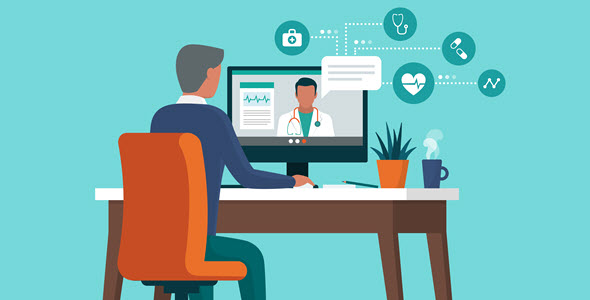By the bioMérieux Connection Editors
The novel coronavirus has caused everyone around the world to live and work in different ways, including healthcare providers. Clinicians have had to seek new ways to serve patients while not contributing to the rapid spread of COVID-19. Many health systems and medical practices found a solution in telemedicine—according to a late April survey, 85% of practices said they were performing telehealth visits, compared to only 6% before the pandemic.
“Since about mid-March, it’s become a reality and even a likelihood for millions of patients,” Lori Uscher-Pines, a senior policy researcher, said in a recent Washington Post article. “Before then, less than 10 percent of U.S. adults had ever had a telemedicine visit. But COVID-19 [is changing] all that, likely permanently.”
The terms telehealth, telemedicine, and e-health have different connotations when used clinically or legally, but for the general public, they are usually used interchangeably to refer to care provided in a non-face-to-face manner. Teleheath visits can take place via phone call, email, text, or video call, and have been used to address non-urgent health matters or routine management of conditions. Virtual visits have also been helpful in screening individuals presenting with COVID-19 symptoms.
Why Have Telehealth Visits Boomed Amidst the Pandemic?
Telemedicine has been slowly growing in popularity over the past few years, but its use has exploded in a few short months since the onset of the pandemic. In May, Blue Cross and Blue Shield of Massachusetts reported that claims for telehealth visits increased 190-fold since the start of the pandemic, and telehealth visits in the U.S. are projected to climb to 1 billion by the end of 2020.
In some ways, the reasoning behind the large increase in telehealth visits is apparent. Virtually communicating with a healthcare provider saves an individual from having to visit a hospital, urgent care, or medical practice in-person, limiting their exposure to the coronavirus. Telehealth visits also helped avoid overburdening emergency departments and urgent care centers as they focused on severe cases of COVID-19.
Another reason for the immense spike in telemedicine is that many regulatory barriers have been temporarily removed to accelerate the use of telehealth services during the pandemic. In response to the coronavirus outbreak, the U.S. Department of Health and Human Services (HHS) waived most Medicare payment requirements to enable telehealth services to be provided in all settings, including the patient’s home. Additionally, almost all states issued emergency policies making telehealth services more widely available in their Medicaid programs and plans. On top of these regulatory changes, many commercial insurers voluntarily expanded telehealth benefits and reduced or eliminated cost sharing for these visits.
Implications of Telemedicine for Antimicrobial Stewardship
While telemedicine presents many benefits to both patients and providers, there are concerns as well, particularly related to quality of care, because there are clear limitations when it comes to virtual visits. For example, if an individual presents symptoms of COVID-19, a telehealth provider would not be able to take the patient’s temperature or listen to their lungs to evaluate signs of pneumonia. There are also implications related to antimicrobial prescribing, which have been a concern since before the pandemic.
A study published in April of 2019 found that antibiotics were prescribed in 55% of telehealth visits involving children with respiratory conditions. Similarly, in a November 2018 study, it was reported that 66% of adults using telehealth for respiratory tract infections (RTIs) received an antibiotic prescription. The authors of the pediatric study note that that specific stewardship measures for telehealth visits may be needed. They propose that telemedicine providers recommend seeking in-person care when they are uncertain about a bacterial respiratory infection.
“Adherence to stringent criteria for making the diagnoses of RTIs … is essential to judicious antibiotic prescribing,” they write. “Patients suspected of certain diagnoses should be referred to an urgent care center for appropriate testing.”
Amidst COVID-19, antimicrobial stewardship teams have used tele-technology to their benefit. With many physicians and pharmacists working from home, University of North Carolina Hospitals adapted interventions to initiate a tele-antimicrobial stewardship program (tele-ASP). Their tele-ASP incorporates secure, HIPAA-compliant video conferencing to review patients on antimicrobial therapy, as well as secure chats in the electronic medical record system.
“There is a growing body of literature that demonstrates that tele-antimicrobial stewardship programs can effectively improve appropriate antimicrobial use, just as their traditional bricks-and-mortar counterparts do,” Carolina Antimicrobial Stewardship Program Medical Director Nikolaos Mavrogiorgos, who was instrumental in UNC’s tele-ASP, said in a recent article on the topic.
Creating a tele-ASP for telehealth networks would be a difficult undertaking, but it could be an option to consider for improving remote antimicrobial stewardship efforts.
The Future of Telehealth
Although stewardship initiatives may be needed to guide telehealth visits going forward, it has proven to be an effective method for seeing patients while maintaining social distancing. With cities lifting stay-at-home orders, there are questions as to whether telemedicine will sustain the growth it experienced during the pandemic and if there will be long-lasting effects on policy and the regulatory environment.
Juliette Cubanski, PhD, MPP, MPH, thinks data will help illuminate the answers to these questions. She said in a recent CIDRAP article that, “We can look forward to seeing data in the future on how many people took advantage of this and whether it might be something that people will expect to have moving forward.”
Opinions in this article are not necessarily those of bioMérieux, Inc.



